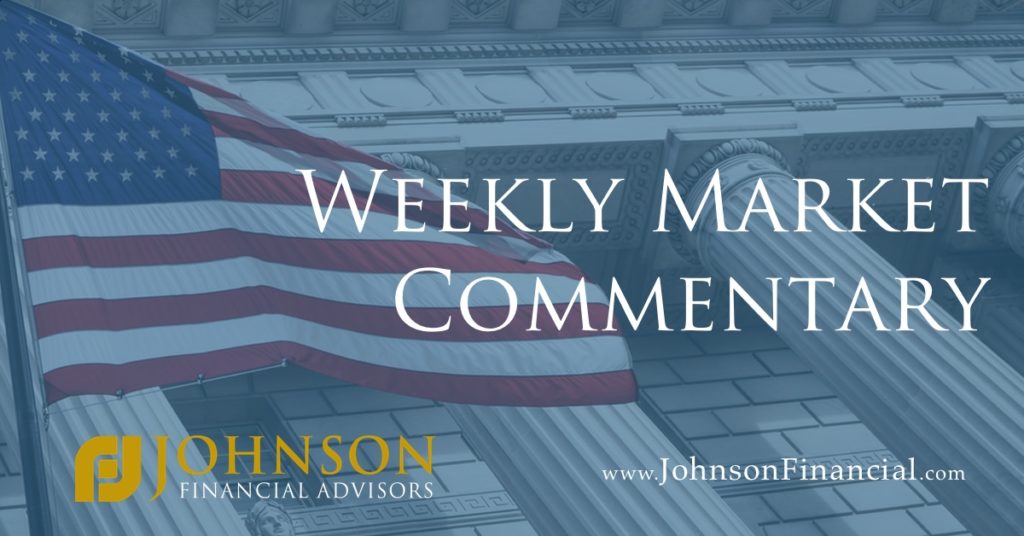
Market Commentary for the Week of November 27, 2017
The Markets
Wall Street broke several records during Friday’s half session. The S&P closed above 2,600 points for the first time. The NASDAQ ended at a record high and posted its best weekly performance since early September. The Dow also booked its first weekly gain in three weeks. For the week, the Dow rose 0.89 percent to close at 23,557.99. The S&P gained 0.93 percent to finish at 2,602.42, and the NASDAQ climbed 1.57 percent to end the week at 6,889.16.
| Returns Through 11/24/17 | 1 Week | YTD | 1 Year | 3 Year | 5 Year |
|---|---|---|---|---|---|
| Dow Jones Industrials (TR) | 0.89 | 21.83 | 26.44 | 12.55 | 15.43 |
| NASDAQ Composite (PR) | 1.57 | 27.98 | 28.04 | 13.16 | 18.35 |
| S&P 500 (TR) | 0.93 | 18.36 | 20.45 | 10.23 | 15.46 |
| Barclays US Agg Bond (TR) | 0.19 | 3.39 | 3.65 | 2.38 | 2.10 |
| MSCI EAFE (TR) | 1.88 | 23.22 | 27.79 | 6.15 | 8.52 |
No Federal Income Taxes — Of American taxpayers, 54 percent (49.8 million out of 92.4 million returns) who reported adjusted gross income less than $50,000 during tax year 2015 did not pay any federal income tax (source: Internal Revenue Service, BTN Research).
We Sell, They Buy — U.S. exports of goods and services to China have increased tenfold since 1999, rising from $17 billion in 1999 to $170 billion in 2016 (source: Commerce Department, BTN Research).
Standard of Living — China’s economy is the second largest in the world behind the United States, but China’s GDP per person is only $9,377 while the United States’ GDP per person is $61,687 (source: IMF, BTN Research).
WEEKLY FOCUS – Smart Giving Tips
Whether it’s due to the holiday spirit or taking advantage of tax deductions before it’s too late, one-fourth of all charitable donations are typically made in the last six weeks of the calendar year. That’s why your mailbox is likely filled with pleas from philanthropic organizations. Just as you try to be a mindful shopper who avoids impulse purchases, it’s important to be a careful giver who thoughtfully evaluates those emotion-tugging appeals. The following tips can help.
Plan ahead. You can’t buy gifts for every friend and relative, and you can’t donate to every worthy cause. So rather than waiting for organizations to come to you, consider what areas you’re most passionate about, thoroughly research prospective charities and choose groups who address your concerns most effectively and efficiently.
Check out national organizations on charity rating sites like GuideStar.org, CharityNavigator.org or the Better Business Bureau Wise Giving Alliance site, Give.org. Evaluate local nonprofits by reading their annual report, audited financial statement and IRS Form 990. Look for entities that spend 75 percent of their budgets directly on programs. You might even volunteer and observe their programming in action.
Concentrate support. After you’ve identified charities with reputations for performing well, narrow your choices. Although diversification works well when investing in stocks, it’s less effective when investing in charities. Giving more to fewer organizations allows them to spend less on fundraising, keep operating costs low and plan strategically.
Budget for giving. Once you’ve chosen your favorite nonprofits, decide how much you want to give and make room in your budget. See if you can make your gifts go farther by participating in a matching program through your employer or a generous donor.
Be tax smart. You can’t deduct donations unless you itemize your tax return and give to a 501(c)(3) tax-exempt entity. (To check whether a charity qualifies, visit the IRS webpage, https://apps.irs.gov/app/eos/). If you receive something in return for your gift (i.e., a dinner or a book), its value must be subtracted from your donation. A canceled check or credit card statement is adequate for gifts under $250, but you’ll need a receipt for gifts above that.
For more information on targeting your charitable efforts, give our office a call. We can also work with your tax advisor to help you and your causes get the most benefit from your gifts.
We do not provide tax advice; coordinate with your tax advisor regarding your specific situation.
Source: Morningstar.com. *Past performance is no guarantee of future results. Indexes are unmanaged and cannot be invested into directly. Three- and five-year returns are annualized. The Dow Jones Industrials, MSCI EAFE, Barclays US Agg Bond and S&P, excluding “1 Week” returns, are based on total return, which is a reflection of return to an investor by reinvesting dividends after the deduction of withholding tax. The NASDAQ is based on price return, which is the capital appreciation of the portfolio, excluding income generated by the assets in the portfolio in the form of interest and dividends. (TR) indicates total return. (PR) indicates price return. MSCI EAFE returns stated in U.S. dollars.
* The Standard & Poor’s 500 (S&P 500) is an unmanaged group of securities considered to be representative of the stock market in general. The Dow Jones Industrial Average is a price-weighted index of 30 actively traded blue-chip stocks. NASDAQ Composite Index is an unmanaged, market-weighted index of all over-the-counter common stocks traded on the National Association of Securities Dealers Automated Quotation System. The Morgan Stanley Capital International Europe, Australia and Far East Index (MSCI EAFE Index) is a widely recognized benchmark of non-U.S. stock markets. It is an unmanaged index composed of a sample of companies representative of the market structure of 20 European and Pacific Basin countries and includes reinvestment of all dividends. Barclays Capital Aggregate Bond Index is an unmanaged index comprised of U.S. investment-grade, fixed-rate bond market securities, including government, government agency, corporate and mortgage-backed securities between one and 10 years. Written by Securities America, Copyright October 2017. All rights reserved. Securities offered through Securities America, Inc., Member FINRA/SIPC. SAI# 1911159.1
